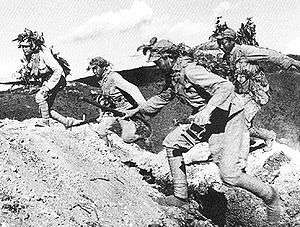Battle of Wanjialing
Battle of Wanjialing, known in Chinese text as the Victory of Wanjialing (simplified Chinese: 万家岭大捷; traditional Chinese: 萬家嶺大捷; pinyin: Wànjiālǐng Dàjíe), refers to the Chinese Army's successful engagement during the Wuhan theatre of the Second Sino-Japanese War against the Japanese 101st, 106th, 9th and 27th divisions around the Wanjialing region in 1938. The two and a half month battle resulted in heavy losses of the Japanese 101st and 106th Divisions.
Combatants
Chinese
In the Battle of Wanjialing, the Chinese side consisted of the 4th Army, the elite 74th Army, 66th Army, 187th Division, 91st Division, New 13th Division, 142nd Division, 60th Division, Reserved 6th Division, 19th Division, a brigade from the 139th Division and the New 15th Division, which totals up to 100,000 men. The chief commander in the frontline was the commander of the 9th Group Army Wu Qiwei. They were under the overall command of the supreme commander of the 9th Military Region Xue Yue.
Japanese
The Japanese side consisted of the 106th Division, led by Lieutenant-General Junrokurō Matsuura. Under the 106th Division, there were the 111th Infantry Brigade (113th and 147th Infantry Regiments) and 136th Brigade (123rd and 145th Infantry Regiments), as well as regiments of cavalry, artillery, engineers and transport. During the battle, the 101st Division was also deployed. Later during the battle, the (9th and 27th divisions) would also be deployed.
Battle
Under the orders of Yasuji Okamura, the Japanese 106th Division intended to cross the Wanjialing 萬家嶺 Region in hopes to cut through to the rear of De'an 德安 as direct approach from Jiujiang 九江 along the railway line south and approach by 101st Division by pushing through from the eastern foothills of Mount Lu was getting nowhere. The plan was discovered by Xue Yue, and the Chinese Army managed to surround the 106th Division with 16 divisions at Lushan. After capturing Jiujiang, 106th Division tried to push south using the Jiujiang to Nanchang railway as the axis and capture De'an. It got a mauling at Shahe 沙河 just south of Jiujiang. On August 21, the Japanese 101st Division's Sato Detachment (Major General Sato Shozaburo 佐藤正三郎, 101 Brigade) consisting of two infantry battalion supported by a battalion of artillery captured Xingzi as part of the push to De'an, but faced fierce resistance from Wang Jingjiu's 25th Corps and Ye Zhao's 66th Corps. Reinforced with Saeda's detachment (Major General Saeda Yoshishige 佐村義重, 101st division) both forces was still unable to break through the Chinese lines, Japanese deployed poison gas. Although the Chinese had a severe shortage of protective equipment against chemical weapons, they were still able to repel the Japanese attack.
At the beginning of September, Okamura ordered the 9th and 27th Divisions to relieve the 106th division, but they were halted by fierce Chinese resistance. On September 24, the Japanese Army finally managed to punch through the Chinese lines in the west, but were then confronted by Ou Zhen's 4th Corps and Yu Jishi's elite 74th Corps and were once again surrounded. Desperate to break open a safe path for their trapped ground forces, the Japanese Air Force began heavy bombing on Chinese positions with incendiary bombs, resulting in many Chinese deaths.
On October 7, the Chinese suddenly launched fierce counter-attacks and the remaining Japanese units that were still intact hastily retreated. Combat ended on October 10, which was coincidentally the Chinese National Celebration Day. On October 13, the Chinese forces withdrew from the battlefield.
Aftermath
The two and a half month battle caused tremendous casualties for the Japanese army, the failed offensive resulting in the crippling of the Japanese 101st and 106th divisions. These two divisions initially had a combined strength of over 47,000 troops, and lost about 30,000 men in battle. In particular, the Japanese officer corps took a particularly heavy hit, the high casualty rate forcing General Shunroku Hata to frequently airdrop replacement officers onto the bases of his besieged units throughout the battle.
For the Chinese, the successful defense of Wanjialing played a key role in the overall Wuhan campaign, halting the Japanese offensive drive towards Wuhan along the southern bank of the Yangtze River, and buying invaluable time for the Chinese government to evacuate its civilian population, war facilities, and industrial assets away from the city and westward towards cities such as the new wartime capital of Chongqing.
